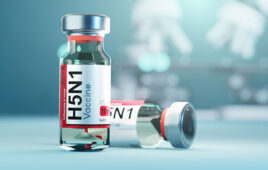|
Adoption of and adherence to self-injectable therapies are critical issues faced by both patients and the pharmaceutical companies providing the therapy. Patients often lack the confidence to self-inject or are put off by the complexity of injection, thus impacting their willingness and ability to incorporate these therapies into their lifestyle. This can have serious effects on a patient’s quality of life and disease progression. A recent study of 2,648 patients with relapsing-remitting multiple sclerosis, patients who were not adherent to their self-injectable treatment (25%) reported a diminished quality of life and more neuropsychological issues compared to patients who were adherent to treatment.1
There have been significant advancements in needle-free injection technology, which aim to increase adoption of self-injectable therapies and adherence. Needle-free drug delivery systems, which have been around since the 1940’s, may now be poised to become mainstream. Once used almost exclusively by healthcare professionals for mass vaccinations and insulin delivery, needle-free delivery systems are now available for home use. However, while there has been significant evolution in jet injection technology, greater acceptance within the pharmaceutical industry has been hampered by uneven performance observed with pre-2010 technologies.
Unlike newer needle-free systems, this early technology was designed primarily to eliminate issues associated with needle use in the clinic for mass vaccination using stationary systems. These multi-use systems increased the risk of disease transmission, requiring disinfection after use. Subsequent generations included integrated, hand-held 510k-regulated devices, but many remained non-specific with respect to intramuscular or subcutaneous delivery depth. Rarely were they clinically studied by pharmaceutical companies and subsequently added to the label of the drug product. Other than the intended benefit of addressing needle-phobia, the patient experience remained far from optimal. Pain and injection site tolerability was not always equal to or better than using a traditional needle and syringe. These issues ultimately restrained broader adoption of the second-generation injectors.
|
Today, research studies have demonstrated that patient experiences associated with the designs from the last century simply don’t hold true with newer needle-free drug delivery systems. In modern jet injection systems, such as the DosePro needle-free delivery system from Zogenix, pain was typically described by subjects as mild discomfort to mild pain, with no difference in pain sensation observed between needle-free and needle-based injection. Clinical studies also found that bleeding and swelling, if any, following injection with the DosePro system was comparable to needle-based injection, typically small (for blood: droplet of 1mm or less; for swelling: median size 4 mm) and self-resolving.2
The goal of modern needle-free injection is to increase the prescribing and adoption of important drugs that require self-injection, such as biologics. Innovators in needle-free injection technologies aim to achieve this by improving the patient experience and removing the barriers to self-injection, such as the fear of needles, lack of confidence to self-inject, and dealing with the complexity of needle-based injections (such as manipulating the needle or syringe and managing safe disposal).
A 2006 study commissioned by Vyteris Inc. found that more than 15 million American adults and five million children over the age of five suffer from high discomfort or exhibit needle-phobic behavior when faced with getting a blood draw or injection. In a study of 300 rheumatoid arthritis (RA) sufferers, commissioned by Battelle in 2012, the number of patients that would accept self-injection therapy increases by 30% if a needle-free option is available. By offering a needle-free option, companies can therefore improve adoption of self-injection therapy, while reducing the fear associated with needle and syringe injection.
Newer needle-free injection systems also have the potential to be enabling for highly viscous drug products that cannot be delivered by traditional needle and syringe, adding to the utility of the technology. For example, DosePro was shown to deliver formulations up to 400mg/ml in excess of 500cP without degrading delivery time, accuracy, or integrity.3 Additionally, DosePro has demonstrated the clinical reliability for biologics by delivering a number of large molecule formulations including HGH, EPO, G-CSF, and monoclonal antibodies.
Studies have also found that drug delivery from needle-free injection systems does not damage the therapeutic. An in vitro study conducted by Battelle showed that DosePro can deliver AbbVie’s Humira (adalimumab) without incremental risk to protein denaturation and equivalent biological integrity as compared to delivery by pre-filled syringe.4 The absence of silicone oil and tungsten residuals in the primary container has also been viewed favorably for long-term protein stability.
The world of needle-free injection has changed drastically, with advances that include the commercial launch of refillable needle-free injection technologies for use with approved drug products such as Teva Pharmaceutical’s Tev-Tropin Tjet and EMD Serono’s Saizen cool.click systems, which have improved the patient experience in the pediatric delivery of human growth hormone. More recently, the FDA approved Sumavel DosePro, a single-use, prefilled needle-free drug product designed to improve the patient experience with self-injection. Prescriptions for injectable sumatriptan in the U.S. declined from 2005 to 2010 when Sumavel DosePro was launched. As more companies begin to recognize the benefits, needle-free injection technology will continue to grow in popularity, both among patients and physicians, and ultimately increase adoption of injectable drug therapies.
References
1. Eur J Neurol. 2011 Jan;18(1):69-77. doi: 10.1111/j.1468-1331.2010.03110.x.
2. Smith, et al. Safety and Tolerability of the DosePro Needle-Free Drug Delivery System, AAPS Poster Presentation, 2011.
3. Boyd, et al. DosePro Needle-Free Delivery of Viscous Formulations, AAPS Poster Presentation, 2011.
4. In Vitro Stability of a Monoclonal Antibody, Adalimumab, after DosePro Instantaneous Delivery.
Filed Under: Drug Discovery





